How Scientists Look for the Truth
Today I toured around the work stations of each of the scientists studying Modified Circumpolar Deep Water: Drs. Josh Kohut, Chris Measures, Phoebe Lam, Angelicque White, Allen Milligan, and Adam Kustka. They’re all here because they have a hypothesis about how MCDW contributes to the summer blooms of phytoplankton that provide so much food to the animals of the Ross Sea.
As the expedition goes on, we’ll look at each of these scientists’ work in detail, but today I just wanted to know how their work all fits together. One of the most basic aspects of being a scientist is using the scientific method. You observe a pattern, you suggest a hypothesis to explain it, and then you think of ways to test that explanation to see if it’s the right one. Some hypotheses are easy to test, but this one stretches across so many scientific fields that it takes six separate experts—spanning physics, chemistry, biology, and engineering. Read on through the slideshow and we’ll break down those parts one by one:
- At the heart of the study are the unusual characteristics of Modified Circumpolar Deep Water, and that’s why yesterday’s post focused on it. There were three key things to remember: that it comes from a much larger, nutrient-rich current that flows around Antarctica, that MCDW has been underwater for so long that it contains unusually low amounts of oxygen, and that its density (determined by temperature and salinity) keeps it flowing in a characteristic depth range as it travels through the Ross Sea. This expedition’s scientists think that when MCDW comes into the Ross Sea it carries those nutrients with it, and they eventually reach phytoplankton, spurring it to grow into huge blooms of food.
- That’s what a hypothesis is: it’s a possible explanation for a pattern that someone has observed. But scientists don’t accept a hypothesis just because it sounds reasonable. They want to gather evidence to see if it’s right. So they use their knowledge and imagination to think of other explanations that also sound reasonable. Then they design ways to test which are right and which are wrong. In what different ways could their explanation of MCDW’s effects be wrong? Let’s see…
- The ocean is a variable place, and currents that went one direction one year might change course the next year. Before we claim that MCDW helps phytoplankton to bloom, we need to make sure it’s here. That’s what Dr. Kohut’s team from Rutgers University is doing. They send out gliders to survey the waters for the characteristic temperature, salinity, and oxygen values of MCDW (see yesterday’s post).
- Maybe MCDW is flowing through the Ross Sea—but if it doesn’t contain many nutrients, it won’t be useful to phytoplankton. To test this, Dr. Chris Measures (pictured) of the University of Hawaii measures the amount of dissolved iron, aluminum, and manganese in water samples. Dr. Measures’s results help other scientists on the ship know how much iron to use in experiments that simulate MCDW. Dr. Phoebe Lam of Woods Hole Oceanographic Institution tests the water for particles of iron and neodymium.
- Because iron is such an important nutrient for plant growth (we’ll discuss why in a future post), it would be helpful to know whether MCDW carries iron in from the deep ocean, or whether it picks it up as it scours the seafloor on its way into the Ross Sea. Dr. Measures and Dr. Lam are analyzing metals in the seawater to learn this. Dr. Lam also uses the hefty, waist-high pumps in this photo to find out how much organic matter phytoplankton are producing.
- Maybe we’ll find that MCDW has plenty of nutrients in it—that doesn’t automatically mean that phytoplankton will start growing. Maybe something else they need is missing, or perhaps the dense MCDW never makes it all the way up to the shallow water where the phytoplankton are. To find out, Dr. Angelicque White and Dr. Allen Milligan of Oregon State University are analyzing the seawater to see what kind of phytoplankton are growing, and how fast they are growing. They compare this to Dr. Kohut’s measurements of where MCDW is.
- Even once we find a phytoplankton bloom that has MCDW beneath it, we still can’t say for sure that MCDW is the cause. But experiments done by Dr. Adam Kustka on the deck of the Palmer can help link cause and effect. His team takes water from the surface and adds one of the following: water collected from deep inside a patch of MCDW; water collected from deep down but not in MCDW; or an amount of iron equivalent to what’s in MCDW, but without the water. Dr. Kustka keeps the samples cold and shines a constant light on them, allowing them to grow for 9 days. These experimental conditions will allow him to tell whether MCDW has any effect, if it’s the iron in MCDW that causes the bloom, or if it’s some other quality of MCDW, and not just iron.
- This morning we woke to find a flock of 80 Antarctic petrels playing in the wind around our ship. These birds are long-distance fliers that travel all over the Ross Sea and Southern Ocean snatching marine prey from the waves with their hooked bills. Our science team spent the whole day here, at a place called the Pennell Banks, where the water was relatively shallow (about 700 feet deep) and green with phytoplankton. The petrels probably don’t mind what kind of water produces the food they live on, but we want to know. After our voyage is over and our hypotheses have been tested, we’ll have a better idea.
That’s an introduction to the scientists who are studying Modified Circumpolar Deep Water. Four other groups are on board as well, studying other parts of the Ross Sea. These are led by Dr. Bruce Huber of Lamont-Doherty Earth Observatory, Dr. Walker Smith of Virginia Institute of Marine Sciences, Dr. Rebecca Gast of Woods Hole Oceanographic Institution, and Dr. Bob Sanders of Temple University. We’ll tell you about them in coming posts—starting with Dr. Huber tomorrow.


 January 23, 2011
January 23, 2011 
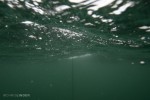
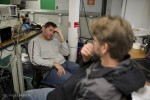
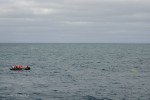

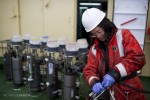
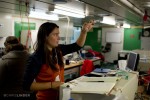
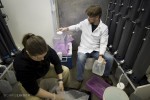
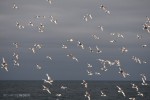







6 Responses to “How Scientists Look for the Truth”